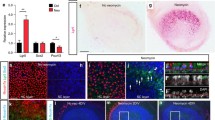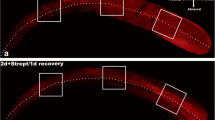Abstract
In this study, we present a systematic characterization of hair cell loss and regeneration in the chicken utricle in vivo. A single unilateral surgical delivery of streptomycin caused robust decline of hair cell numbers in striolar as well as extrastriolar regions, which in the striola was detected very early, 6 h post-insult. During the initial 12 h of damage response, we observed global repression of DNA replication, in contrast to the natural, mitotic hair cell production in undamaged control utricles. Regeneration of hair cells in striolar and extrastriolar regions occurred via high rates of asymmetric supporting cell divisions, accompanied by delayed replenishment by symmetric division. While asymmetric division of supporting cells is the main regenerative response to aminoglycoside damage, the detection of symmetric divisions supports the concept of direct transdifferentiation where supporting cells need to be replenished after their phenotypic conversion into new hair cells. Supporting cell divisions appear to be well coordinated because total supporting cell numbers throughout the regenerative process were invariant, despite the initial large-scale loss of hair cells. We conclude that a single ototoxic drug application provides an experimental framework to study the precise onset and timing of utricle hair cell regeneration in vivo. Our findings indicate that initial triggers and signaling events occur already within a few hours after aminoglycoside exposure. Direct transdifferentiation and asymmetric division of supporting cells to generate new hair cells subsequently happen largely in parallel and persist for several days.






Similar content being viewed by others
Change history
03 January 2018
This article was updated to correct a formatting error in Table 1.
07 May 2018
This article was updated to correct a formatting error in Table��1.
References
Adler HJ, Raphael Y (1996) New hair cells arise from supporting cell conversion in the acoustically damaged chick inner ear. Neurosci Lett 205:17–20
Adler HJ, Komeda M, Raphael Y (1997) Further evidence for supporting cell conversion in the damaged avian basilar papilla. Int J Dev Neurosci 15:375–385
Alvarado DM et al (2011) An RNA interference-based screen of transcription factor genes identifies pathways necessary for sensory regeneration in the avian inner ear. J Neurosci 31:4535–4543. https://doi.org/10.1523/JNEUROSCI.5456-10.2011
Benjamini Y, Hochberg Y (1995) Controlling the false discovery rate: a practical and powerful approach to multiple testing. Journal of the Royal Statistical Society: Series B (Statistical Methodology) 57:289–300
Brigande JV, Heller S (2009) Quo vadis, hair cell regeneration? Nat Neurosci 12:679–685. https://doi.org/10.1038/nn.2311
Burns JC, Corwin JT (2013) A historical to present-day account of efforts to answer the question: “what puts the brakes on mammalian hair cell regeneration?”. Hear Res 297:52–67. https://doi.org/10.1016/j.heares.2013.01.005
Burns JC, On D, Baker W, Collado MS, Corwin JT (2012) Over half the hair cells in the mouse utricle first appear after birth, with significant numbers originating from early postnatal mitotic production in peripheral and striolar growth zones. J Assoc Res Otolaryngol 13:609–627. https://doi.org/10.1007/s10162-012-0337-0
Cafaro J, Lee GS, Stone JS (2007) Atoh1 expression defines activated progenitors and differentiating hair cells during avian hair cell regeneration. Dev Dyn 236:156–170. https://doi.org/10.1002/dvdy.21023
Cheraghali AM, Knaus EE, Wiebe LI (1994) Bioavailability and pharmacokinetic parameters for 5-ethyl-2′-deoxyuridine. Antivir Res 25:259–267
Corwin JT, Cotanche DA (1988) Regeneration of sensory hair cells after acoustic trauma. Science 240:1772–1774
Dye BJ, Frank TC, Newlands SD, Dickman JD (1999) Distribution and time course of hair cell regeneration in the pigeon utricle. Hear Res 133:17–26
Golub JS, Tong L, Ngyuen TB, Hume CR, Palmiter RD, Rubel EW, Stone JS (2012) Hair cell replacement in adult mouse utricles after targeted ablation of hair cells with diphtheria toxin. J Neurosci 32:15093–15105. https://doi.org/10.1523/JNEUROSCI.1709-12.2012
Grompe M (2012) Tissue stem cells: new tools and functional diversity. Cell Stem Cell 10:685–689. https://doi.org/10.1016/j.stem.2012.04.006
Hume CR, Bratt DL, Oesterle EC (2007) Expression of LHX3 and SOX2 during mouse inner ear development. Gene Expr Patterns 7:798–807. https://doi.org/10.1016/j.modgep.2007.05.002
Jorgensen JM, Mathiesen C (1988) The avian inner ear. Continuous production of hair cells in vestibular sensory organs, but not in the auditory papilla. Naturwissenschaften 75:319–320
Kaiser CL, Kamien AJ, Shah PA, Chapman BJ, Cotanche DA (2009) 5-Ethynyl-2′-deoxyuridine labeling detects proliferating cells in the regenerating avian cochlea. Laryngoscope 119:1770–1775. https://doi.org/10.1002/lary.20557
Ku YC, Renaud NA, Veile RA, Helms C, Voelker CC, Warchol ME, Lovett M (2014) The transcriptome of utricle hair cell regeneration in the avian inner ear. J Neurosci 34:3523–3535. https://doi.org/10.1523/JNEUROSCI.2606-13.2014
Li H, Liu H, Heller S (2003) Pluripotent stem cells from the adult mouse inner ear. Nat Med 9:1293–1299
Matiašová A, Sevc J, Mikeš J, Jendželovský R, Daxnerová Z, Fedoročko P (2014) Flow cytometric determination of 5-bromo-2′-deoxyuridine pharmacokinetics in blood serum after intraperitoneal administration to rats and mice. Histochem Cell Biol 142:703–712. https://doi.org/10.1007/s00418-014-1253-7
Matsui JI, Oesterle EC, Stone JS, Rubel EW (2000) Characterization of damage and regeneration in cultured avian utricles. J Assoc Res Otolaryngol 1:46–63
Meyers JR, Hu Z, Lu Z, Corwin JT (2009) Hair cell regeneration. In: Squire LR (ed) Encyclopedia of neuroscience, Academic Press, Oxford, pp 1005–1013
Oesterle EC, Tsue TT, Reh TA, Rubel EW (1993) Hair-cell regeneration in organ cultures of the postnatal chicken inner ear. Hear Res 70:85–108
Roberson DF, Weisleder P, Bohrer PS, Rubel EW (1992) Ongoing production of sensory cells in the vestibular epithelium of the chick. Hear Res 57:166–174
Roberson DW, Kreig CS, Rubel EW (1996) Light microscopic evidence that direct transdifferentiation gives rise to new hair cells in regenerating avian auditory epithelium. Audit Neurosci 2:195–205
Roberson DW, Alosi JA, Cotanche DA (2004) Direct transdifferentiation gives rise to the earliest new hair cells in regenerating avian auditory epithelium. J Neurosci Res 78:461–471. https://doi.org/10.1002/jnr.20271
Rubel EW, Furrer SA, Stone JS (2013) A brief history of hair cell regeneration research and speculations on the future. Hear Res 297:42–51. https://doi.org/10.1016/j.heares.2012.12.014
Ryals BM, Rubel EW (1988) Hair cell regeneration after acoustic trauma in adult Coturnix quail. Science 240:1774–1776
Shang J, Cafaro J, Nehmer R, Stone J (2010) Supporting cell division is not required for regeneration of auditory hair cells after ototoxic injury in vitro. J Assoc Res Otolaryngol 11:203–222. https://doi.org/10.1007/s10162-009-0206-7
Stone JS, Cotanche DA (2007) Hair cell regeneration in the avian auditory epithelium. Int J Dev Biol 51:633–647. https://doi.org/10.1387/ijdb.072408js
Stone JS, Rubel EW (1999) Delta1 expression during avian hair cell regeneration. Development 126:961–973
Stone JS, Rubel EW (2000) Temporal, spatial, and morphologic features of hair cell regeneration in the avian basilar papilla. J Comp Neurol 417:1–16
Stone JS, Choi YS, Woolley SM, Yamashita H, Rubel EW (1999) Progenitor cell cycling during hair cell regeneration in the vestibular and auditory epithelia of the chick. J Neurocytol 28:863–876
Stone JS, Shang JL, Tomarev S (2004) cProx1 immunoreactivity distinguishes progenitor cells and predicts hair cell fate during avian hair cell regeneration. Dev Dyn 230:597–614. https://doi.org/10.1002/dvdy.20087
Tsue TT, Oesterle EC, Rubel EW (1994) Diffusible factors regulate hair cell regeneration in the avian inner ear. Proc Natl Acad Sci U S A 91:1584–1588
Wang T et al (2015) Lgr5+ cells regenerate hair cells via proliferation and direct transdifferentiation in damaged neonatal mouse utricle. Nat Commun 6:6613. https://doi.org/10.1038/ncomms7613
Warchol ME, Speck JD (2007) Expression of GATA3 and tenascin in the avian vestibular maculae: normative patterns and changes during sensory regeneration. J Comp Neurol 500:646–657. https://doi.org/10.1002/cne.21153
Warchol ME, Lambert PR, Goldstein BJ, Forge A, Corwin JT (1993) Regenerative proliferation in inner ear sensory epithelia from adult guinea pigs and humans. Science 259:1619–1622
Warchol ME, Stone J, Barton M, Ku J, Veile R, Daudet N, Lovett M (2017) ADAM10 and γ-secretase regulate sensory regeneration in the avian vestibular organs. Dev Biol 428:39–51. https://doi.org/10.1016/j.ydbio.2017.05.014
Weisleder P, Rubel EW (1993) Hair cell regeneration after streptomycin toxicity in the avian vestibular epithelium. J Comp Neurol 331:97–110. https://doi.org/10.1002/cne.903310106
Zakir M, Dickman JD (2006) Regeneration of vestibular otolith afferents after ototoxic damage. J Neurosci 26:2881–2893. https://doi.org/10.1523/JNEUROSCI.3903-05.2006
Acknowledgments
A special thank you to Stephanie Jensen (Stanford Veterinary Service Center) for her exceptional help and support in establishing the surgery protocol; to Jialin Shang (University of Washington) for assistance with tissue preparation; to J. David Dickman (Baylor) and Mark Warchol (Washington University) for consulting and enthusing discussions; and to Amanda Janesick, Giovanni H Diaz, and Byron H. Hartman for equally enthusing discussions and comments on the manuscript.
Funding
This work was supported by the Hearing Health Foundation’s Hearing Restoration Project and by the Stanford Initiative to Cure Hearing Loss. M.S. was supported in part by a fellowship (SCHM 2804/1-1) from the Deutsche Forschungsgemeinschaft; D.C.E. was supported in part by a Stanford Dean’s fellowship.
Author information
Authors and Affiliations
Corresponding author
Ethics declarations
Animal procedures were approved by the Stanford University Institutional Animal Care and Use Committee (IACUC).
Additional information
This article was updated to correct a formatting error in Table 1.
Rights and permissions
About this article
Cite this article
Scheibinger, M., Ellwanger, D.C., Corrales, C.E. et al. Aminoglycoside Damage and Hair Cell Regeneration in the Chicken Utricle. JARO 19, 17–29 (2018). https://doi.org/10.1007/s10162-017-0646-4
Received:
Accepted:
Published:
Issue Date:
DOI: https://doi.org/10.1007/s10162-017-0646-4




